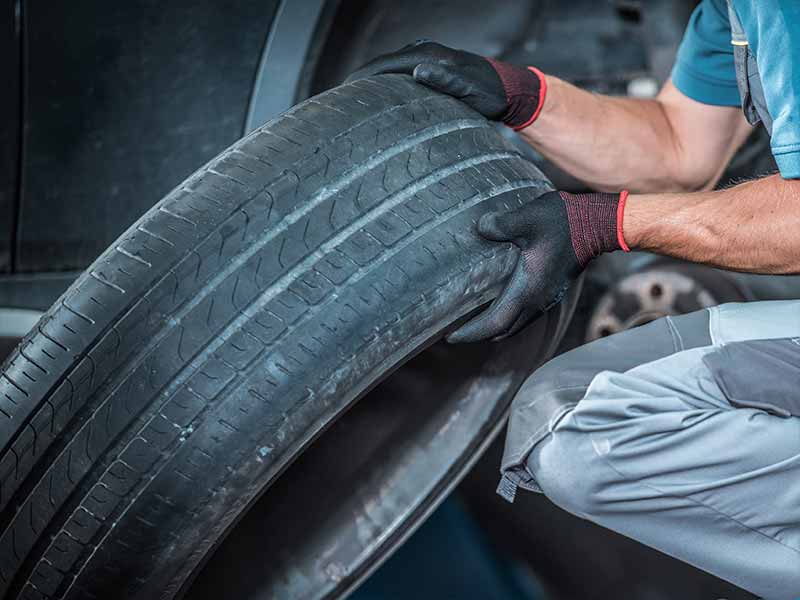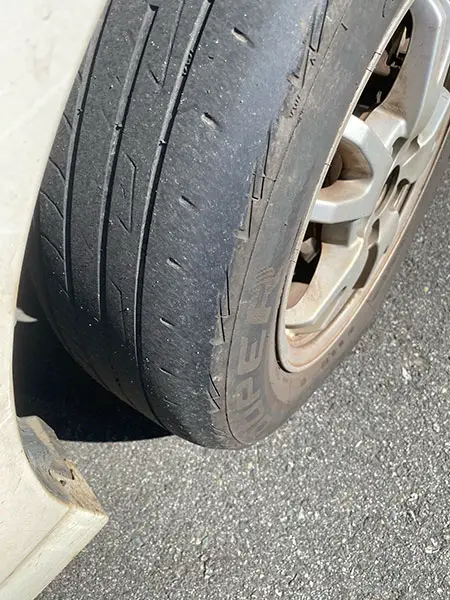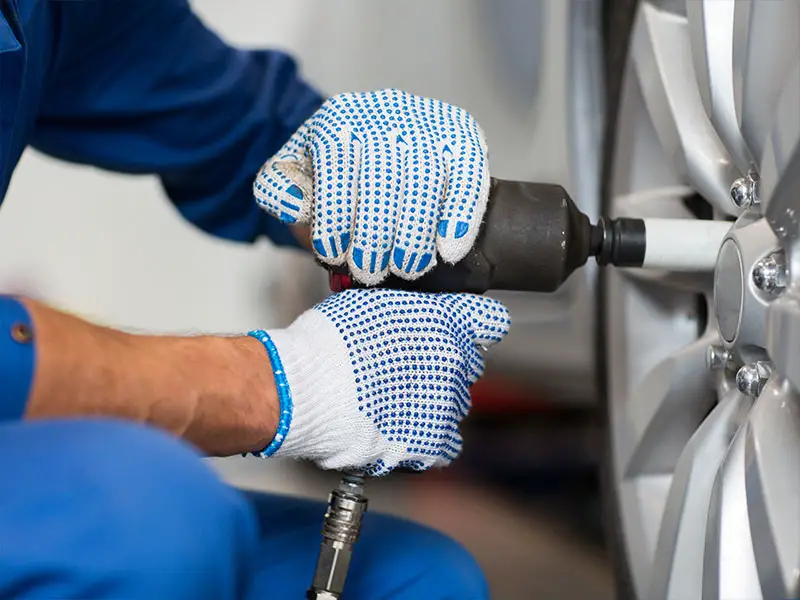Tire rotation is important for tire life. It ensures car tires wear evenly. Front and rear tires come into contact with the road surface at different angles to improve handling, stability, and traction.
These angles cause the tires to wear unevenly and if tire rotation isn’t regularly performed, you will end up with no tread depth left on one part of your tire tread and almost new tread depth elsewhere.
Let’s dive into the importance and effects of tire rotation.
Is Tire Rotation Really Necessary?
Tire rotation is necessary to prevent voiding your tire warranty. It is also important to extend the life of your expensive tires and ensure they perform properly.
Tires are one of the most important components of your car or truck and ensuring that they are capable of performing their best in an emergency situation can be critical.

Do I Really Need To Rotate My Tires?
While you don’t technically need to rotate your tires, your tires will likely not last as long and you will void the tire manufacturer’s warranty if you don’t have this inexpensive service performed on the schedule required by the manufacturer.
Some car owners will see little benefit from regularly rotating their tires, while others will see huge benefits.
The effect of tire rotation is affected by a few different factors:
Driving Style
Probably the biggest factor that will affect the longevity of your tires and whether tire rotation will be a small or big benefit is how you drive.
Aggressive drivers will wear down tires extremely quickly, while conservative drivers may be able to exceed the manufacturer’s warrantied mileage with little effort.
It shouldn’t be surprising to find out that hard cornering, aggressive braking, and jack rabbit starts all cause your tires to wear down much more quickly.
Due to suspension geometries that are designed to improve traction and handling characteristics, your tires will not wear evenly and will need to be rotated more frequently to ensure the tires wear as evenly as possible to maximize tread life.
Vehicle Type
Family sedans and SUVs tend to have more conservative suspension geometries and tend to keep the tires more evenly in contact with the road surface. This is ideal for tread wear.
Sports cars have more aggressive suspension geometries that are designed to maximize handling and traction. These more extreme suspension designs usually cause tires to wear much less evenly across the tire tread.
Suspension/Wheel/Tire Maintenance
Maintaining your alignment, tire pressures, and ensuring your wheels are not out of round are important to getting the most out of your tires.
Neglecting to stay on top of these maintenance tasks will all lead to more accelerated tire wear. Tire rotation can help alleviate some of the negative affects of poor maintenance habits, but it isn’t a solution.
Ensuring that your tire pressures are correct, wheels aren’t bent and are balanced, and your suspension is aligned are all key factors to getting the most out of your tires.
I’ve seen new cars and trucks that often don’t benefit as much from tire rotations.
TireGrades Expert Tip
But old and new vehicles all benefit from maintaining the tire warranty.
What Happens If You Don’t Rotate Your Tires?
Your tires don’t contact the road perfectly evenly. This is due to the vehicle manufacturers suspension design which helps maximize grip for the road conditions the car or truck is designed to cope with.
Your front tires are usually toed in or out slightly. Toe in means the front of the tires, when looking down on the car from the top, are pointed slightly toward the middle of the car. Toe out is simply the opposite of this with the front of the tires pointed slightly away from the middle of the vehicle.
This suspension adjustment improves stability but causes slightly uneven wear across the tire tread. Toe in is usually best for rear wear drive vehicles and toe out is best for front wheel drive cars.
Toe can cause wear on the outer edges of the tire tread.
Your rear tires are usually adjusted to have slight negative camber. Negative camber means the tires are tilted slightly inward at the top of the tire when viewed from the back of the car or truck. This suspension adjustment improves traction but also causes uneven wear across the tire tread.
Tires with negative camber ride more in the inner edge of the tire tread.
There are also slight inconsistencies in the suspension parts, adjustments, wheels, and tires themselves that can all lead to slightly inconsistent tire wear patterns.
If you don’t keep your tires rotated regularly the portions of the tire tread that have the most pressure will wear more quickly than those will less pressure.
Benefits of Tire Rotation
Tire rotation changes the way the tread comes into contact with the road and helps you better use the tire tread across the entire tread surface.
The tires at each corner of your car or truck come into contact with the road surface differently, especially front to back. By moving a tire to a different position, it will come into contact with the road surface differently, and will wear more on a different spot of the tire tread.
This will extend the life of your tires by preventing them from being completely worn out in one area of the tread (such as the inner shoulder) while having almost new tread in another area (such as the outer shoulder).

Worn Outer Tire Tread
Another benefit of regularly rotating tires is maintaining the tire manufacturer warranty. Tire warranties are often overlooked benefits you should be taking advantage of to save you quite a bit of money depending on the type of vehicle you drive and your driving style.
A tire that is warrantied to 50,000 miles that is worn out at 30,000 miles can provide you with a discount on a new set of tires for the 20,000 miles of unrealized tread wear you were guaranteed to receive.
The catch is you need provide proof that you rotated the tires according to the tire manufacturer’s recommended rotation schedule. If you don’t regularly have your tires rotated you will not meet this requirement and will have voided the warranty.
This is a huge benefit tire manufacturer’s provide consumers. Many vehicles, such as sports cars, will wear unevenly by design because they are designed to maximize handling and traction at the expense of tread wear. It’s highly unlikely that tires on a sports car will last as long as the tire manufacturer’s warranty but you can still claim the warranty if you perform rotations as required.
How Often Do You Really Need To Rotate Tires?
Rotating your tires is necessary to maintain the tire manufacturer’s warranty. If you have a set of tires that are warrantied to 50,000 miles, you must provide proof that you have rotated them according the tire manufacturer’s requirements for maintaining the warranty.
If you aren’t concerned with the warranty, you will still want to rotate your tires regularly to get the most tread life out of them. Tires are not inexpensive and taking the time to have them rotated is well worth the small amount of money that you might spend to have this tire maintenance service performed.
It’s often recommended to have your tires rotated while other services are also being performed so that you can kill two birds with one stone. No one enjoys waiting on their car or truck while it’s being serviced, but often, the majority of your time spent is traveling to and from the maintenance service appointment. It’s also much more convenient to combined time-consuming appoints into a single visit when possible.
How Long Will Tires Last If Not Rotated?
The length of time or number of miles that tires will last when not rotated depends on many variables. It’s not possible to say accurately how long they will last for your unique situation, but you can expect that they will last much less than the tire manufacturer’s warrantied mileage.
Driving style has a profound effect on how many miles a set of tires will last. Aggressive driving will more quickly wear tread off of any set of tires. This is especially true if they aren’t rotated since they won’t be given any opportunity to evenly distribute the wear across the tire tread over time.
Not rotating tires keeps the patch of tire tread with the most pressure on the same section of tread for the life of the tire.
Do Tires Wear Faster If You Don’t Rotate Them?
Tires will almost always wear out more quickly if they aren’t rotated. The will not wear faster if not rotated.
They are simply only wearing more on one part of the tire tread and not evenly distributing the wear across the tread by rotating them.
The reason is that your car or truck doesn’t usually ride with the tires perfectly flat and aligned straight on the pavement surface. This causes the tire tread wear to be uneven.
It’s common for tires that aren’t rotated regularly to wear on the inside or outside of the tread more than the opposite side. By rotating your tires regularly around your vehicle, the areas that are more worn can get moved to a position that wears the vehicle tires more in an area of tread that has more life left.
Common Tire Rotation Patterns
To get the most out of your tires you need to rotate them with a rotation pattern that the vehicle manufacturers recommend.
Differences between a front wheel drive car, rear wheel drive, and all wheel drive vehicle all cause unique tire wear patterns. This means tire rotation patterns vary depending on which axles are driving the wheels.
Refer to your owner’s manual for the best rotation pattern for your car or truck.
Forward Cross – Front Wheel Drive Vehicles
The forward cross is ideal for front wheel drive vehicles. The rear tires move to the front and switch sides while the front tires move to the rear and stay on the same side.
Rearward Cross – Rear & All Wheel Drive Vehicles
The rearward cross the inverse of the forward cross pattern. Rear tires move to the front without switching sides while the front tires move to the rear and switch sides.
X-Pattern – FWD, RWD, & AWD
The X-Pattern is most versatile tire rotation pattern and can work with most vehicle drive layouts.
The front tires move to the rear and the rear tires move to the front. All tires switch sides.
Final Thoughts
Performing tire rotations according to the tire manufacturer’s required schedule is required to maintain the tire warranty.
Ensure the rotation pattern used follows the recommendation in your owner’s manual.
Try to have tires rotated while other services are being performed to save time and money.
Resources
Below are some links you may find helpful when learning about tires




